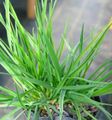Difference between revisions of "Koeleria macrantha"
m (Tag: VisualEditor) |
|||
| (4 intermediate revisions by 2 users not shown) | |||
| Line 1: | Line 1: | ||
| − | ''' | + | * Latin Name: ''Koeleria'' ''macrantha'' |
| − | + | * Family: Poaceae | |
| − | ''' | + | * Common Names: Koeler's prairie grass, prairie junegrass |
| + | * Synonyms/Misapplications: ''Koeleria'' ''cristata, Koeleria'' ''gracilis, Koeleria'' ''nitida, Koeleria'' ''yukonensis'' | ||
| + | * Codon: KOEMAC | ||
==Taxonomy== | ==Taxonomy== | ||
==Description== | ==Description== | ||
| + | Native, perennial, cool season bunchgrass.<ref name=":0">Ogle, | ||
| + | Daniel G. 2012. Plant fact sheet for prairie junegrass (Koeleria macrantha). | ||
| + | USDA-Natural Resources Conservation Service, Boise, ID</ref> | ||
| − | + | Leaf sheaths are open, leaves are 1-2mm broad, and basally tufted. | |
| − | + | Culms are 3-6 dm tall, topped with fluffy-appearing, congested inflorescences (4-13cm.) which form a spike-like panicle. | |
| + | The spikelets are mostly 2-flowered and are borne on short pedicels with paleas shorter than the lemmas<ref name=":1">Bowcutt, F., & Hamman, Sarah. (2016). ''Vascular plants | ||
| + | of the South Sound prairies'' (First ed.). Olympia, Washington: The Evergreen | ||
| + | State College Press.</ref> | ||
| + | ==Bloom Period== | ||
| + | May - June<ref name=":1" /> | ||
| + | ==Distribution== | ||
| + | Alaska south, on both sides of Cascades, to northern Mexico, east across most of North America to Atlantic.<ref>Hitchcock, C. L., Cronquist, A., Giblin, D., & Legler, | ||
| + | B. et al. (2018). ''Flora of the Pacific Northwest: an illustrated manual''. | ||
| + | Seattle: University of Washington Press.</ref> | ||
==Habitat== | ==Habitat== | ||
| + | Dry, sandy prairies; open woods; rocky slopes | ||
| + | Dry, well-drained soils such as silts to loams to sandy loams. It has good tolerance to fire.<ref name=":0" /> | ||
==Uses== | ==Uses== | ||
| + | Prairie junegrass is used as a component of native seed mixtures in revegetation of mined lands, heavy use areas and other surface disturbed lands.Prairie Junegrass acts as a early- seral species of previously water-stressed areas.<ref>Simonin, Kevin. 2000. Koeleria macrantha. In: Fire Effects Information System, [Online]. | ||
| + | U.S. Department of Agriculture, Forest Service, | ||
| + | Rocky Mountain Research Station, Fire Sciences Laboratory (Producer). | ||
| + | Available: <nowiki>https://www.fs.fed.us</nowiki> | ||
| + | /database/feis/plants/graminoid/junroe/all.html [2020, June 9].</ref> | ||
| − | = | + | Medium palatable for browsing animals and high palatability for grazing animals. Prairie junegrass is considered a fair to good forage for elk throughout the year and is desirable forage for deer and antelope in the spring and early summer.<ref name=":0" /> |
| − | + | ||
| − | + | ||
==Photo Gallery== | ==Photo Gallery== | ||
| + | <gallery> | ||
| + | File:KOEMAC2.jpg|photo by Craig Althen, 2010. | ||
| + | File:KOEMAC3.jpg|Sheathing leaf, photo by Robert L. Carr, 2013 | ||
| + | File:KOEMAC4.jpg|Photo Robert L. Carr, 2013 | ||
| + | File:KOEMAC5.png|Seedling, courtesy of CNLM | ||
| + | File:KOEMAC6.jpg|Courtesy of CNLM | ||
| + | </gallery> | ||
| + | |||
| + | === References === | ||
Revision as of 18:36, 9 June 2020
- Latin Name: Koeleria macrantha
- Family: Poaceae
- Common Names: Koeler's prairie grass, prairie junegrass
- Synonyms/Misapplications: Koeleria cristata, Koeleria gracilis, Koeleria nitida, Koeleria yukonensis
- Codon: KOEMAC
Contents
Taxonomy
Description
Native, perennial, cool season bunchgrass.[1]
Leaf sheaths are open, leaves are 1-2mm broad, and basally tufted.
Culms are 3-6 dm tall, topped with fluffy-appearing, congested inflorescences (4-13cm.) which form a spike-like panicle.
The spikelets are mostly 2-flowered and are borne on short pedicels with paleas shorter than the lemmas[2]
Bloom Period
May - June[2]
Distribution
Alaska south, on both sides of Cascades, to northern Mexico, east across most of North America to Atlantic.[3]
Habitat
Dry, sandy prairies; open woods; rocky slopes Dry, well-drained soils such as silts to loams to sandy loams. It has good tolerance to fire.[1]
Uses
Prairie junegrass is used as a component of native seed mixtures in revegetation of mined lands, heavy use areas and other surface disturbed lands.Prairie Junegrass acts as a early- seral species of previously water-stressed areas.[4]
Medium palatable for browsing animals and high palatability for grazing animals. Prairie junegrass is considered a fair to good forage for elk throughout the year and is desirable forage for deer and antelope in the spring and early summer.[1]
Photo Gallery
References
- ↑ 1.0 1.1 1.2 Ogle, Daniel G. 2012. Plant fact sheet for prairie junegrass (Koeleria macrantha). USDA-Natural Resources Conservation Service, Boise, ID
- ↑ 2.0 2.1 Bowcutt, F., & Hamman, Sarah. (2016). Vascular plants of the South Sound prairies (First ed.). Olympia, Washington: The Evergreen State College Press.
- ↑ Hitchcock, C. L., Cronquist, A., Giblin, D., & Legler, B. et al. (2018). Flora of the Pacific Northwest: an illustrated manual. Seattle: University of Washington Press.
- ↑ Simonin, Kevin. 2000. Koeleria macrantha. In: Fire Effects Information System, [Online]. U.S. Department of Agriculture, Forest Service, Rocky Mountain Research Station, Fire Sciences Laboratory (Producer). Available: https://www.fs.fed.us /database/feis/plants/graminoid/junroe/all.html [2020, June 9].



